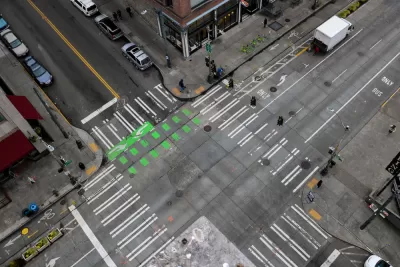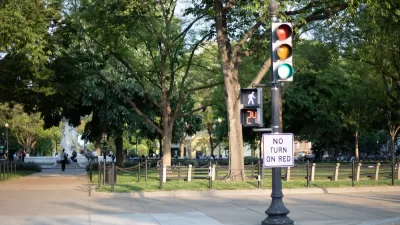Every new traffic light in the city will be required to install ‘No Turn on Red’ signs, a tactic shown to reduce collisions.

All newly installed or repaired traffic signals in Seattle will bar drivers from turning right on red. As Ryan Packer points out in The Urbanist, “The change doesn’t mean that right-on-red will be restricted every single intersection in Seattle anytime soon, but rather that every time a project within the department deals with replacing or modifying a traffic signal, SDOT will have to find a reason justifying not to add ‘no turn on red’ signage.” Allowing cars to turn right on red will now require a “significant operational reason.”
In Washington, D.C., banning right turns on red resulted in a 97 percent reduction in driver-to-driver conflicts and a 92 percent reduction in vehicle-pedestrian conflicts. According to a study published in the Institute of Traffic Engineers (ITE) journal, “These improvements came at overall minor impacts to traffic operations. These findings have helped the District identify a low-cost safety tool that will help in its pursuit of Vision Zero.”
Packer adds that “The new policy will not apply when the city does routine maintenance, or when it modifies signals to add Accessible Pedestrian Signals (APS), which provide low-vision people auditory clues that it’s safe to cross the street. The rule will also not apply when signal timing is the only thing about a signal that is modified.”
SDOT expects roughly 150 intersections will have restricted turns on red by the end of this year, “still just a fraction of the over 1,000 signalized intersections that SDOT maintains citywide.”
FULL STORY: No Right Turn on Red Is Now the Default in Seattle

Rethinking Redlining
For decades we have blamed 100-year-old maps for the patterns of spatial racial inequity that persist in American cities today. An esteemed researcher says: we’ve got it all wrong.

Planetizen Federal Action Tracker
A weekly monitor of how Trump’s orders and actions are impacting planners and planning in America.

Walmart Announces Nationwide EV Charging Network
The company plans to install electric car chargers at most of its stores by 2030.

Seattle’s Pike Place Market Leans Into Pedestrian Infrastructure
After decades of debate, the market is testing a car ban in one of its busiest areas and adding walking links to the surrounding neighborhood.

The World’s Longest Light Rail Line is in… Los Angeles?
In a city not known for its public transit, the 48.5-mile A Line is the longest of its kind on the planet.

Quantifying Social Infrastructure
New developments have clear rules for ensuring surrounding roads, water, and sewers can handle new users. Why not do the same for community amenities?
Urban Design for Planners 1: Software Tools
This six-course series explores essential urban design concepts using open source software and equips planners with the tools they need to participate fully in the urban design process.
Planning for Universal Design
Learn the tools for implementing Universal Design in planning regulations.
City of Moorpark
City of Tustin
City of Camden Redevelopment Agency
City of Astoria
Transportation Research & Education Center (TREC) at Portland State University
Regional Transportation Commission of Southern Nevada
Toledo-Lucas County Plan Commissions





























